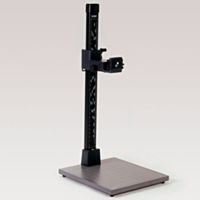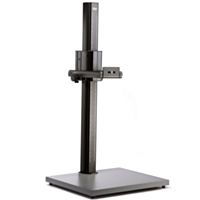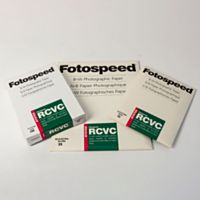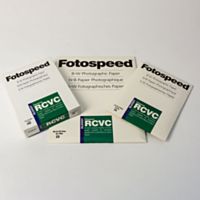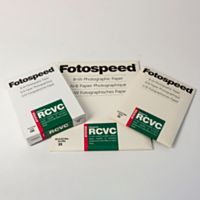Tim Jones: Black and White Papers - The best papers so far for 2020

Tim Jones is our Tech Support wizard at Fotospeed. Tim is fantastic with all things printing and has an answer for nearly any problem. In this blog, Tim discusses the black and white printing process from capturing to the final print.
Setting up for black and white printing
The two main questions I get asked when people are looking to print black and white are:
Do I use the black and white mode on the printer?
Do I need a profile to print black and white?
The black and white modes on the printers are great and they do a great job, however for me, the greys in the print do not come out perfectly natural. They also rely on the printer's colour management, and therefore have inconsistent results from print to print.
I always recommend for people to have a custom profile made if they are printing colour or black and white, and this is even more important when printing black and white images. We profile the printer in the normal way, with a colour management chart. As your print uses coloured ink even when printing black and white prints, we use a full colour chart and this produces natural black and white prints with no colour casts within the image.
Here at Fotospeed (via a special request), we can refine the profile for black and white printing by generating a second chart to ‘fill in’ where the profile needs more information.
Converting your images and processing:
As with all digital photography, I recommend shooting RAW as your standard file format on your camera. This will allow you to pull a lot more information from your file and give you a better black and white conversion.
Once the file has loaded onto the computer, I use either Photoshop camera RAW or Lightroom to convert the file into black and white. You can learn how to do this over on our YouTube. Both do a great job at converting. Once you’ve done your basic change from colour to black and white, it's time to start editing.
This can be done either by globe adjustment or as I recommend, local adjustments focusing on and changing different parts of the image via layer masks in Photoshop, and the brush tool in Lightroom.
Once your image is ready to print, we now come to paper choice. This can be one of the most important decisions when making any print be it colour or black and white. Below I have listed a selection of my favourites that work really well for monoprinting:

Platinum Baryta is our go to paper when we think of printing black and white. The paper gives deep blacks and holds highlights perfectly. Baryta papers come from the darkroom and are digital versions of fibre-based papers. If you are looking to publish your black and whites while holding the important details, definitely look at Baryta.

Platinum Gloss Art Fibre is another Baryta-based paper we offer. As with the Platinum Baryta, this paper will produce stunning black and whites. Where the Gloss Art Fibre differs is it has a slightly higher white point and a subtle texture, feeling a little more like a fibre-based darkroom paper. This is another one of my go to papers when printing black and white and looking for a darkroom look.

Legacy Gloss is a paper with a warm base, and gives your photographs the look of a warmer tone paper of the past. Legacy Gloss is a Baryta-based paper, which will give you the feel of darkroom papers. When printing on Legacy, I usually choose an image with more shadows than highlights. It naturally suits landscapes and wildlife photography, as well as architecture photography.

With NST Bright White we are into the world of matt papers. Matt papers have not always been linked with black and white printing, however, monoprints look amazing on matt paper and it's definitely worth trying out. The NST Bright White has a high D-MAX giving a deep black to any image, an aspect that can be lacking in some matt papers. It’s the deep black and clean white highlights that make it perfect for black and white photographs, and the paper feels amazing in your hand as well. I personally use this paper when shooting black and white weddings, high key portraits, street photography and landscapes.

Platinum Matt is a paper I have recently started using, and it has become one of my favourite papers for black and white printing. It has a high white point making your photograph really stand out. It also has a high D-MAX, giving those deep blacks we keep talking about.
Platinum Matt is a smooth paper and is perfect for portrait, still-life and street photography. I have also printed abstract work on Platinum Matt with great results, especially with a high key and high contrast image. It can also handle landscapes and does them beautifully, however if you prefer a slight bit of texture in your landscape prints, you should probably pick the NST Bright White.

Hahnemühle’s Baryta FB is a beautiful paper for black and white prints. Baryta FB has a smooth, bright white finish which makes it perfect for street photography and portraits, and works particularly well with high contrast black and white images. The paper's weight of 350gsm also helps the photographs feel more like a darkroom print.

Fine Art Baryta from Hahnemühle is a paper that is part of Hahnemühle’s Baryta range. It differs from Baryta FB as it has a warmer base and personally I feel it suits landscapes and wildlife photography really well, especially for black and white printing.
Hahnemühle Photo Rag Bright White:

Photo Rag bright is a very similar paper to our own Fotospeed NST Bright White paper. A matt paper that gives amazingly deep blacks along with clear highlights. The texture of the Photo Rag papers is stunning and suits any genre of photography from portrait to landscapes. I’d recommend testing this out for your images.

If you are looking for a natural, eco-friendly paper for your black and white prints then the natural range from Hahnemühle is a good place to start. My favourite of these papers for black and white images is the Agave.
It has a lovely texture suiting landscape and still-life photography really well, with good black and clear highlights. It takes a little bit of work in editing to get the balance right between shadows and highlights, as the Agave can, as I call ‘suck’ the contrast a little, so small levels of adjustments are needed, but it’s worth the effort.

Baryta Prestige is my choice of paper for black and white images from Canson. You have to feel this paper, as it feels just like a darkroom paper. In my opinion, it's a shame to mount and frame anything printed on Prestige as it works beautifully in portfolios where the viewer has the ability to pick the prints up and feel them.
As for the print quality, it is perfect for black and white printing, with a high D-MAX and clear and punchy highlights, it's a paper for all types of photography. For me though, having printed portraits on this paper, portraits are this paper's strong point.
For more tips and tricks, check out Fotospeed’s YouTube channel and sign up to the newsletter.



